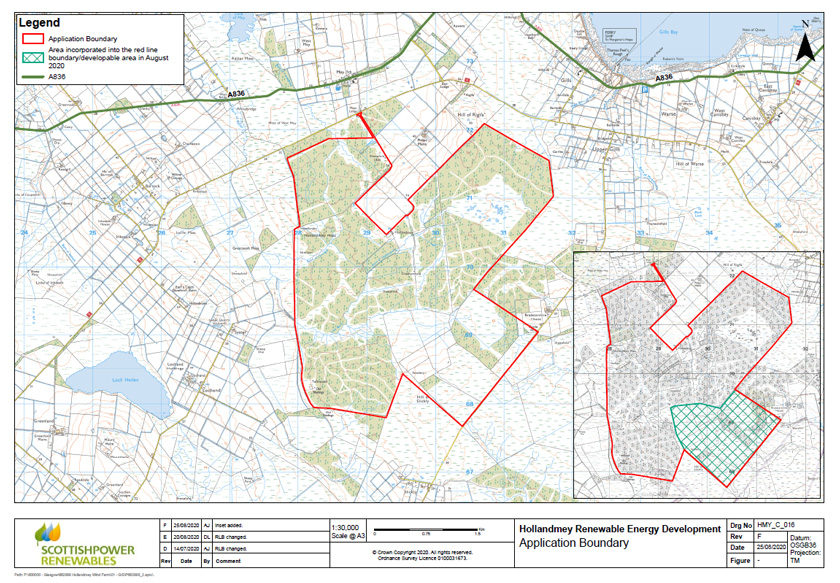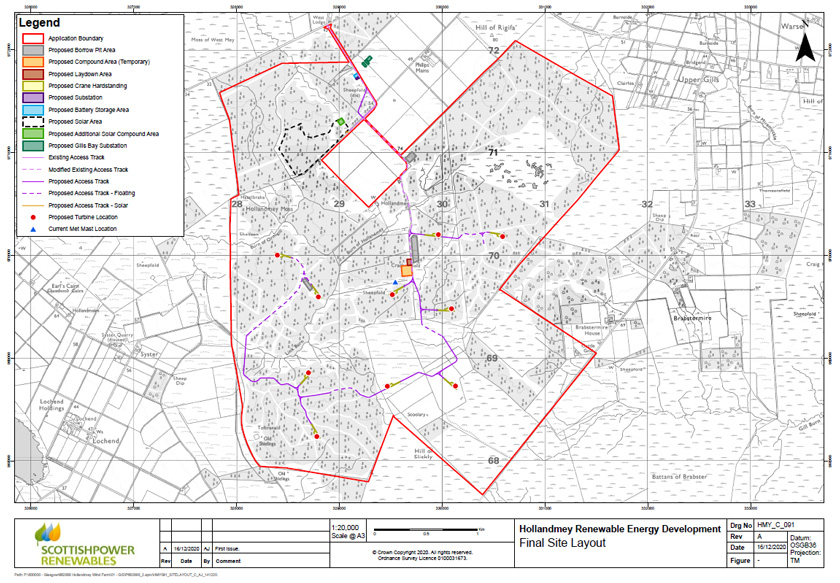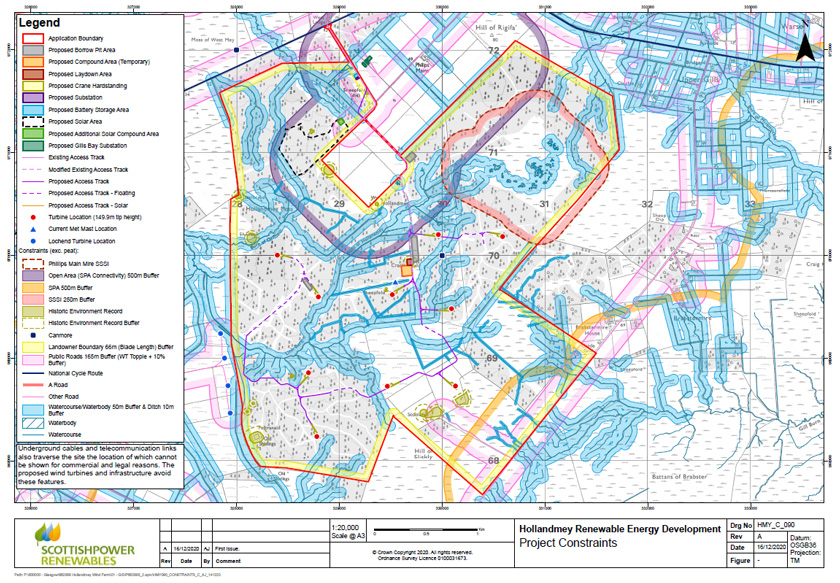The proposed Site boundary is shown below:

View a larger version of the map above
The application boundary has evolved as the project has progressed. Since we distributed our initial leaflet on 03 August 2020, the application boundary has extended to include the land to the south east. This area has also been the subject of environmental surveys, constraints-led design and ongoing environmental impact assessment. This application boundary differs to the map that was shown on scoping documentation and the initial information leaflet; however, the scope and methodology proposed in those documents and agreed with consultees remains relevant and has also been applied to this area.
Work Undertaken to Date
SPR has a good understanding of the Site having completed a comprehensive suite of feasibility assessments, environmental surveys and technical studies. This work has been ongoing since 2017 and has allowed for a thorough collection of the baseline data necessary for designing the proposed Development and conducting the EIA.
This understanding has been bolstered by information provided by stakeholders during Scoping and further consultation, and by feedback received during our first Public Information Event. This information was used to influence design.
An iterative, constraints-led approach was adopted, meaning that the design reacted to the environmental data as it was collected so that, where possible, likely significant effects could be avoided by design. Avoidance is the best form of mitigation and has been SPR’s preferred approach on this project.
Now that the design of the proposed Development has been finalised we have sought to identify potential impacts and evaluate the sensitivity of potential receptors. The wealth of data collected ensures that the specialists can complete robust assessments and identify appropriate mitigation measures to determine whether there would be any likely significant residual effects. There is no proposal to limit the lifetime of the proposed Development. Therefore, the assessment of potential effects on all aspects will consider the operational phase of the proposed Development without time limitations.
SPR are in the process of preparing the EIA Report, which will accompany the Section 36 (S36) application to the Scottish Ministers for consent for the proposed Development. The EIA Report will allow the Scottish Ministers to make a fully informed decision and adds greater transparency and accountability to the planning system. The EIA Report will also be made publicly available and members of the public will have the opportunity to submit representations to the Scottish Ministers, which will be considered in the planning decision.
The final Site layout, which has taken account of all known environmental and physical constraints identified, is shown below.

View a larger version of the map above
Key Project Details
 | 10 wind turbines generating around 50 megawatts with a maximum height to blade tip of 149.9 metres |

| Battery Energy Storage System (BESS) with a storage capacity of around 15 megawatts and potential ground mounted solar array |
 | Generating capacity of around 65 megawatts, from turbines and BESS (not including potential ground mounted solar array) |
 | Generating enough electricity to supply the equivalent of over 37,000* UK homes. |
* using the formula described on the RUK website, 50 MW installed capacity x 0.3114 “all wind” load factor x 8,760 hours / 3.618 MWh annual consumption = 37,698 homes powered equivalent. Number of homes equivalent is subject to change with the addition of solar on the site.
Site Design Considerations
The Site was chosen for a number of reasons including:
- The excellent wind resource on Site which means good wind speeds for energy generation;
- There are no national or international nature designations within the area identified for development; and
- The Site is in close proximity to transport and grid connections and benefits from an existing commercial forestry track network.
Initial feasibility and design work indicated that the Site has the potential to accommodate around 10 wind turbines of up to 149.9 metres to blade tip, an associated Battery Energy Storage System (BESS) and ground mounted solar array. The proposed design has sought to find an appropriate balance between optimising the energy yield and minimising the environmental effects. This is important to maximise the contribution the proposed Development would make to the Scottish Government’s renewable energy and climate change targets, and the response to the climate emergency.
In addition, the BESS could be used to smooth out variances between available resource and electricity demand. It can also be used to provide services to help stabilise the operation of the local electricity network. This will become increasingly important as the electrification of the energy sector intensifies.
As a result of this feasibility and design work, key constraints were identified and a proposed Site layout was designed with respect to these constraints.
The proposed Site layout in the context of these constraints is shown below:

View a larger version of the map above
Construction of the proposed Development is anticipated to commence in 2024 and would take approximately 22 months.
The table below explains the development and EIA process and timeline that the project is following. Since the first Public Information Event the proposed S36 application date has been extended to late 2021, to allow for additional environmental surveys to be undertaken as well as further consultation with key stakeholders and communities.
Development and Environmental Impact Assessment (EIA) Process
Initial Site investigation and design | Initial Site viability and project feasibility assessment. |
EIA Scoping consultations: Summer 2020 | Identifying and agreeing with stakeholders what aspects and potential effects of the development should be covered by the EIA, through Direct Scoping with consultees. |
Public engagement: Summer 2020 | A leaflet was mailed to all properties within 10 km of the Site introducing the concept of the proposed Development. |
On Site and desktop surveys: Spring – Winter 2020 | Research to establish what the conditions of the Site are today, this will allow the effects of the predicted changes to be assessed. |
Public consultation: Autumn 2020 | 1st Public Information Event hosted online – Introducing Project. |
Design evolution and environmental assessment: Spring – Winter 2020 | Iterative process to optimise the design to achieve balance between Site performance and environmental effects. It also sought to identify measures to eliminate, avoid, reduce or mitigate any potentially significant effects where possible. |
Public consultation: Winter 2020/21 | 2nd Public Information Event hosted online. The current Public Information Event to provide the local community with an update regarding the design evolution and EIA progress. |
Submission of application for consent: Late 2021 | We will submit an application to build and operate the proposed Development to the Scottish Ministers for determination under Section 36 of the Electricity Act 1989. |
Evaluation and determination of the application | The Section 36 application will be administered by the Scottish Government Energy Consents Unit (ECU) on behalf of Scottish Ministers. There will be an opportunity at this stage for you to make formal representations on the application to the ECU. These will then be taken into account by Scottish Ministers when determining whether to grant consent for the proposed Development. Timescales for determination are variable and dependent upon case-specific issues but typically take between 12 to 15 months. |
Go back to the main pageGo to the next page